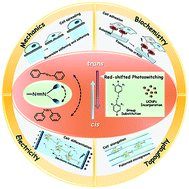Spatiotemporal regulation of dynamic cell microenvironment signals based on an azobenzene photoswitch
Abstract
Dynamic biochemical and biophysical signals of cellular matrix define and regulate tissue-specific cell functions and fate. To recapitulate this complex environment in vitro, biomaterials based on structural- or degradation-tunable polymers have emerged as powerful platforms for regulating the “on-demand” cell-material dynamic interplay. As one of the most prevalent photoswitch molecules, the photoisomerization of azobenzene demonstrates a unique advantage in the construction of dynamic substrates. Moreover, the development of azobenzene-containing biomaterials is particularly helpful in elucidating cells that adapt to a dynamic microenvironment or integrate spatiotemporal variations of signals. Herein, this minireview, places emphasis on the research progress of azobenzene photoswitches in the dynamic regulation of matrix signals. Some techniques and material design methods have been discussed to provide some theoretical guidance for the rational and efficient design of azopolymer-based material platforms. In addition, considering that the UV-light response of traditional azobenzene photoswitches is not conducive to biological applications, we have summarized the recent approaches to red-shifting the light wavelength for azobenzene activation.

- This article is part of the themed collection: Journal of Materials Chemistry B Recent Review Articles


 Please wait while we load your content...
Please wait while we load your content...